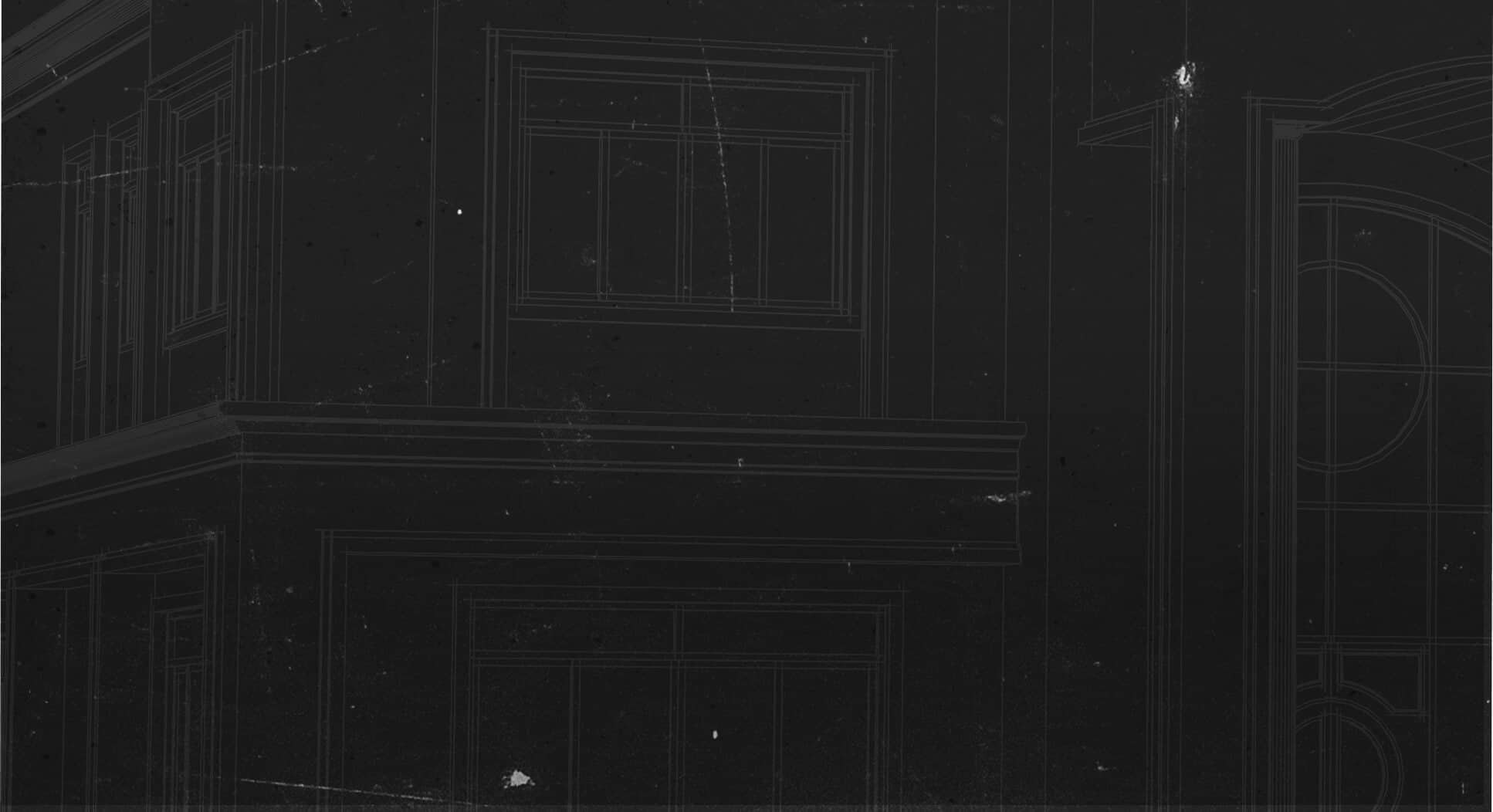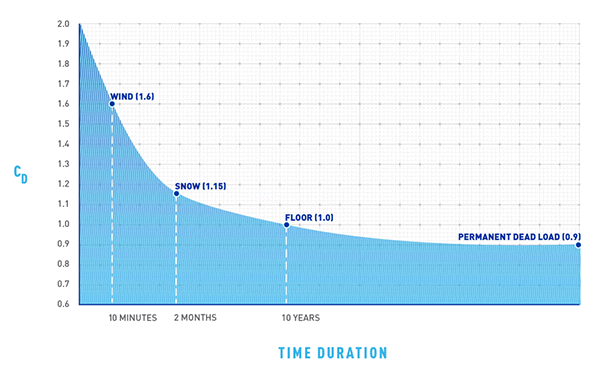
ICC CODE COUNTS ARTICLE
ICC CODE COUNTS ARTICLE: JUNE 2017
LOAD DURATION FACTORS
HED: EXPLAINING THE MEANING OF LOAD DURATION FACTORS
By: Jim Collins Ph.D., P.E., at MiTek USA, Inc.
Builders and code officials who have spent any time around wood-framed construction likely know about load duration factors, formally designated CD. If a building is designed for snow loads, for example, they probably know the roof trusses can be designed with a 1.15 load duration factor. On the other hand, if wind is the controlling factor, they know roof trusses can be designed with a CD = 1.6.
But that’s probably where the understanding of load duration ends. Indeed, while they see the CD factors all the time, a vast majority of those in the construction industry may not fully understand how they are determined, the special qualities of wood that allow for them, and the inherent design efficiency they afford.
Load duration factors for wood are not directly referenced in the International Building Code (IBC) or International Residential Code (IRC). They are referenced in the National Design Specification (NDS) for Wood Construction by the American Wood Council which is a Reference Standard in both Codes (ANSI/AWC NDS-2015).
UNDERSTANDING LOAD DURATION FACTORS
To begin to understand this phenomenon, compare your arm with a wood beam. Both have fibers (muscle fibers in the arm, cellulose fibers in the wood) and both have an “allowable” strength they can safely support without being damaged. Like a wood beam, the muscles in your arm (the fibers) allow you to hold your arm out perpendicular to your body (parallel to the ground) for an extended period of time.
Without any additional weight you would be able to hold your arm up that way for a fairly long time. But if you added weight to your arm, the amount of time you could hold it out would shorten. The more weight you added, the less time you would be able to hold it out straight.
If asked to lift a “heavy” load, you might be able to lift and hold it parallel to the ground, but only for a few seconds. With our arm muscle, there is an “allowable” load that we can support without damaging the muscle fiber. You can think of this as a factor of safety that defines the maximum allowable load your arm can support for a specific time period. If you put too much weight on the arm for too long, that factor of safety is reduced and the muscle fibers may become damaged.
As an intuitive introduction only, this is how the concept of load duration works with wood. Through many scientific tests that have been verified over time, it is a well-established fact that there is an inherent efficiency in wood that allows it to be “overloaded” by a prescribed percentage without reducing its factor of safety, provided the total time it is overloaded does not exceed a prescribed amount of accumulated time (key word: accumulated). Using these established load duration factors, construction industry professionals can be assured that their buildings are being designed most efficiently and can still withstand these increased loads without reducing the factor of safety against damaging the lumber.
HOW LOAD DURATION FACTORS ARE DETERMINED
Load duration factors are only used in Allowable Stress Design (Section 2306.1 of the 2015 IBC), which incorporates a Factor of Safety that separates Allowable load from Ultimate load. Strength Design, also called LRFD, also accounts for load duration but does not directly use a CD factor in this fashion. Load duration factors have been determined for a variety of building situations and the original testing started in the 1940s. The most typical factors used today are derived from a graph similar to the one linked here.
HERE’S A LOOK AT SOME COMMON CASES:
- Dead loads: Dead loads are permanent and constant (Section 1606.1 of the 2015 IBC). Under dead load (without any other load type applied) a wood structure has a reduction in its allowable stress and uses a CD of 0.9. That means the allowable stress of the wood must be reduced by 10 percent.
- Floors: wood joists and trusses used in floors typically have a 1.0 CD, meaning they can safely be stressed at 100 percent of their allowable design load for a total accumulated time of 10 years. A Cd = 1.0 is referred to as Normal Duration since there is neither an increase nor decrease in the allowable stress.
- Snow: The 1.15 CD is used for roofs designed for snow loads. Testing has shown that wood can safely resist a 15-percent increase in its maximum allowable load as long as the total accumulated time under this load does not exceed two months.
- Wind and Seismic: Buildings subjected to earthquakes or wind use a 1.6 CD. This means wooden components can safely handle a 60-percent increase in their maximum allowable load provided the total accumulated time under this load does not exceed 10 minutes.
Buildings are designed for multiple load cases (dead load, dead + live, dead + live + wind, etc.). See Section 1605.3 of the 2015 IBC for all other load combinations. When designing for these multiple scenarios, the load duration factor associated with the load having the shortest time period is used for that particular load case. In principle, each load case is checked using the appropriate CD, to determine which one controls the design of that particular component. The bottom line is this: if the lumber was to be overstressed beyond the point of its load duration factors and for longer than the allowed time period, the factor of safety against permanent damage will be reduced. In the extreme case, where a high load is applied for a long time, the component may fail.
THE TIME ELEMENT IN LOAD DURATION FACTORS
At this point, you may be wondering about the amount of time associated with load duration factors: it seems rather short before inherent safety is compromised. Does a 1.0 CD mean a floor system will only last 10 years before it’s susceptible to failure or that a 1.15 CD for a roof means it can only last two months under snow before it gives way? The answer is “No,” at least for the vast majority of structures.
This question raises a subtle and sometimes difficult-to-understand concept about load duration factors: Total accumulated time under maximum allowable design load.
An example will help clarify this: Suppose a metal-plate-connected wood floor truss is used in a commercial office floor with a specified design load of 50 psf live and 15 psf dead. Furthermore, let’s assume the truss was efficiently designed for the required span and on-center spacing, and that the bending moment under 65 psf was exactly at 100 percent of its maximum allowable bending moment. Finally, if we assume that 50 psf live load was actually applied during normal office hours, we would have the necessary conditions for a wood member to be loaded to its maximum allowable design load. There would be a 10-year total accumulated time period for this floor to safely resist 65 psf.
However, the key word is “accumulated time”. If the floor is loaded eight hours per day for 260 work days a year, it would have used up 2,080 hours of that 10-year period. That’s just 2.4 percent of the “total accumulated period” for the first year, and at that rate it would take more than 41 years to fully use up the total 10-year period. It is also probably unlikely that 50 psf live load would be applied every work day for 41 years, and as soon as the actual applied load drops below the maximum allowable load, the “clock” stops ticking. Finally, and this is important, if the floor truss was designed such that the maximum bending moment under the application of the 65 psf total load was less than the maximum allowable moment, the clock would never start ticking in the first place. This last scenario is the case in many designs.
Wood has a sort of internal clock and each CD safely takes advantage of that based on the load duration time curve. This clock only begins to tick when the applied load reaches the maximum allowable load multiplied by the CD. For snow, if the design snow load is 30 psf for a roof but the maximum combined stress index is equal to 0.93 for the roof truss, the two-month internal clock would never even start.
Thus, floor or roof systems may only rarely see 100 percent of their allowable design load over decades of service, but even if they do, they still maintain the intended Factor of Safety.
WHY LOAD DURATION FACTORS MATTER
So why does all this matter? In a word, efficiency. Architects and engineers use load duration factors to create more efficient wood designs. That’s because CD factors allow them to safely overstress the wood fibers resulting in a more efficient design.
For example, using a Cd = 1.15, a truss designer can design a roof system to safely support the code-prescribed snow load more economically than one designed with a Cd = 1.0. Both would be safe, but one would cost more than the other, all things being equal.
Without load duration factors, wood-framed buildings would still be safe, but they would be unnecessarily over-designed and less economical. Load duration factors allow for an overstress of the lumber without reducing the factor of safety that’s tied to the lumber’s design properties.
It should be noted that CD is not applied to the modulus of elasticity E (bending stiffness) or to the perpendicular to grain bearing stress Fcperp.
No wonder all wood design today is based on load duration factors – whether it’s fully understood or not.
{Disclosure statement}
The views and opinions expressed in this article are those of MiTek USA, Inc. and do not necessarily reflect those of the International Code Council, or Hanley Wood.

